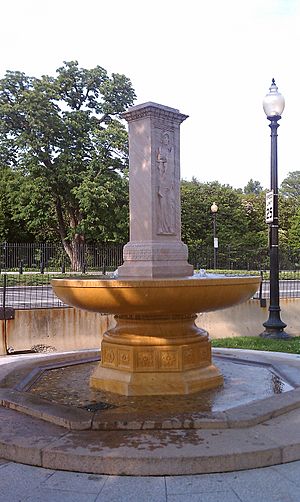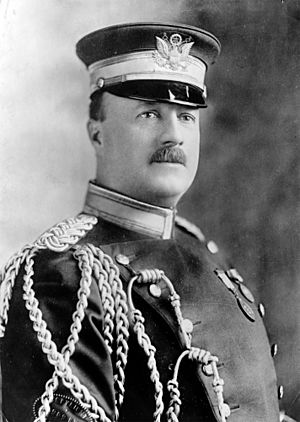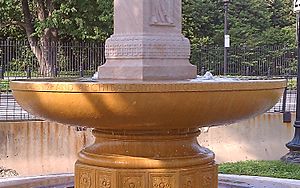Butt–Millet Memorial Fountain facts for kids
 |
|
| Coordinates | 38°53′43″N 77°02′15″W / 38.895269°N 77.037461°W |
|---|---|
| Location | President's Park, Washington, D.C. |
| Designer | Thomas Hastings, designer Daniel Chester French, bas-reliefs |
| Type | Fountain and sculpture |
| Material | Tennessee marble base, granite column |
| Width | 8 ft (2.4 m) |
| Height | 12 ft (3.7 m) |
| Completion date | 1913 |
| Dedicated to | Archibald Butt Francis Davis Millet |
The Butt–Millet Memorial Fountain is a special memorial fountain in President's Park in Washington, D.C., United States. It was officially opened in October 1913. This fountain remembers two important men: Archibald Butt and Francis Davis Millet. Archibald Butt was a military helper to President William Howard Taft. Francis Davis Millet was a journalist and artist, and a very close friend of Butt. Both men sadly died when the famous ship, the RMS Titanic, sank on April 15, 1912.
Contents
Why the Fountain Was Built
Archibald Butt was a Captain in the United States Army. He worked in places like the Philippines and Cuba. President Theodore Roosevelt was very impressed by Butt's hard work. When William Howard Taft became president, he asked Butt to continue as his military helper. Butt was good at solving problems and managing money. He became a key helper for President Taft on money matters for the government. In 1911, Butt was promoted to major.
Butt and Millet lived together in a large house in Washington, D.C. They were known for hosting simple but big parties. Important people like members of Congress and even President Taft attended these parties. Newspapers described their friendship as very strong and deep.
By 1912, President Taft's first term was ending. Roosevelt, who had been friends with Taft, was thinking about running against him for president. Butt was close to both men. This made him feel very stressed and tired. Millet asked President Taft to give Butt a break to rest. Taft agreed. Butt went on a six-week trip to Europe starting on March 1, 1912. Millet went with him.
For their trip back to the United States, Butt booked tickets on the RMS Titanic. He got on the ship on April 10, 1912. Millet joined the ship later that day in Cherbourg, France. On the night of April 14, Butt and Millet were playing cards. The Titanic then hit an iceberg. The ship sank about two and a half hours later. More than 1,500 people lost their lives.
Both Butt and Millet died when the Titanic sank. Butt's body was never found. Millet's body was found on April 27. He was buried in Bridgewater, Massachusetts.
President Taft was heartbroken by Butt's death. He was very sad when he learned Butt had not survived. On May 2, 1912, a service was held for Butt in Augusta, Georgia. Taft spoke at the service. He said that Butt always helped others and was very loyal. A second service was held in Washington, D.C., on May 5.
How the Memorial Was Built
Soon after Butt and Millet died, people wanted to build a memorial for them. On May 16, 1912, Senator Augustus Octavius Bacon suggested building a memorial on government land in Washington, D.C. He said that Butt and Millet were public servants who deserved to be remembered.
President Taft agreed to lead the committee that would raise money for the memorial. Many people, including government officials, gave money. At first, they thought about putting up a simple bronze plaque. But then, they decided to make it a fountain.
The memorial committee chose Thomas Hastings and Daniel Chester French to design the memorial. By April 1913, they decided the memorial would be a fountain with a tall center part. This center part would have two carved figures. One figure would represent chivalry (like a brave knight), for Butt. The other figure would represent art, for Millet.
Both the President and the Commission of Fine Arts had to approve the design and location. They both said yes. Building the foundation for the fountain started on June 18, 1913. The designers, Hastings and French, did not charge for their work.
President Taft had planned a big ceremony for the memorial. But he was no longer president in late 1913. He had lost the election to Woodrow Wilson. So, the Butt–Millet Memorial Fountain was opened quietly on October 25, 1913, without a big ceremony.
About the Memorial Fountain
The Butt–Millet Memorial Fountain is located in the northwest part of the Ellipse. This area is near the White House in Washington, D.C.
The fountain is about 12 feet (3.7 meters) tall. It has a base made of grey granite. On top of the base is a large, round bowl made of golden brown Tennessee marble. A tall, grey granite column rises from the middle of the bowl.
On this column, there are two carved figures. One figure is a woman holding a paint brush and a palette. This figure represents the fine arts, honoring Francis Davis Millet. The other figure is a man in armor and a helmet, holding a shield. This figure represents military bravery, honoring Archibald Butt.
Water flows from four round shapes in the bowl. It then spills over the edge of the bowl into a shallow pool at the base. The fountain was designed so that horses used by park police could drink from it.
Around the edge of the bowl, there is a message. It says: "In memory of Francis Davis Millet – 1846–1912 – and Archibald Willingham Butt – 1865–1912. This monument has been erected by their friends with the sanction of Congress."
Images for kids






